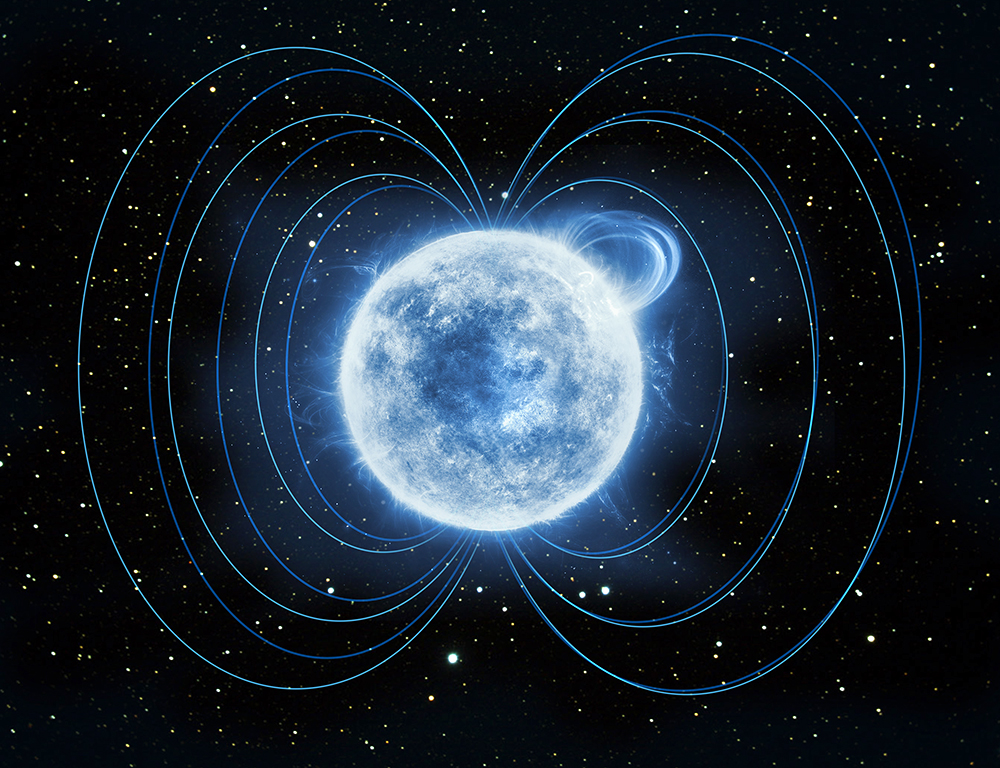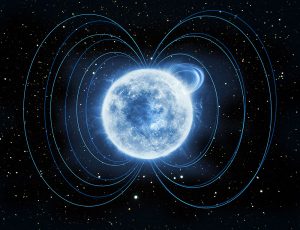Detection by XMM-Newton of a periodic absorption line close to the surface of a Magnetar
The intense and sporadic activity of Magnetars, rotating neutron stars, has its origin in the current model from their extreme magnetic field. At odds to the large majority of the sources of this kind, an exceptionally low value for the magnetic field of SGR 0418+5729 had been recently reported. A European team of researchers, including Diego Götz from the Service d’Astrophysique/laboratory AIM of CEA-Irfu, has reported the detection in X-rays of a faint absorption line, whose intensity and energy are varying regularly. Interpreted as a coupling effect between the charged particle plasma, and the radiation flux coming from a hot spot of the surface of the rotating neutron star, this observation implies an extreme magnetic flied, among the highest in the Universe. This result, published by Nature on August 15th 2013, proves the presence in those objects of different components of the magnetic field, with different intensities.

Variable absorption line
Mid 2009, the Fermi satellite detects a strong activity originating from an unknown source. After a wealth of observations performed by different X-ray satellites, the source, dubbed SGR 0418+5729, has been classified as a Magnetar, and specifically as a Soft Gamma-ray Repeater (SGR). Like ordinary pulsars, Magnetars are rotating neutron stars, compact endpoints of the explosion of massive stars. But conversely to ordinary pulsars, Magnetars are characterized by sporadic activity, slower rotation periods, and a stronger magnetic field. But the intensity of the magnetic field of SGR 0418+5729, or better of its dipolar component (similar to the dipolar magnetic field of the Earth), measurable indirectly thorough the spin down rate of the star, does not fit this picture, being similar to those measured in pulsars (see here to learn more).
The results presented by the team have been obtained thanks to an original and innovative analysis of the data collected by the ESA satellite XMM-Newton. The large collecting surface of this X-ray telescope has allowed the researches to study in detail the energy distribution of the detected photons as a function of the star rotation phase. A structure appears in this kind of representation, see Figure. The former corresponds to a periodic photon deficit at an energy centred around 2 keV. This line is interpreted as a so-called cyclotron resonance absorption feature, which is the signature of the interaction in a magnetic field between the charged particles (in this case protons) and an X-ray flux. Cyclotron absorption lines have been already detected in other sources, but in this case a periodic variation has been reported for the first time. The magnetic field intensity needed to explain the observed line is very high.

Complexity of the magnetic field
The derived magnetic field is of the order of 10**15 Gauss (10**11 Tesla), 1000 times more intense than the one of regular pulsars, one of the most intense of the Universe. As a comparison, the highest magnetic field produced on Earth in a laboratory (like in the large accelerator machine, as the LHC) is of the order of 100 000 Gauss (10 Tesla), and the Earth magnetic field does not even reach 1 Gauss.
These results confirm the complexity of the magnetic field structure of Magnetars, which is made up by different components. In the case of SGR 0418+5729, a dipolar component of the magnetic field, similar to the one expected for a pulsar, and a second more intense component are present around the compact star. This new analysis method has permitted to open a new way to investigate on smaller scales the structure of the magnetic field of neutron stars.
Contact : Diego Götz (CEA)
« A variable absorption feature in the X-ray spectrum of a magnetar »
Andrea Tiengo, Paolo Esposito, Sandro Mereghetti, Roberto Turolla, Luciano Nobili,
Fabio Gastaldello, Diego Götz, Gian Luca Israel, Nanda Rea, Luigi Stella, Silvia Zane &
Giovanni F. Bignami
Revue Nature , 15 août 2013, electronic version : http://arxiv.org/abs/1308.4987
See : The ESA press release
See also : – “Close cousins“, 2010, October
– “Giant magnets in our Galaxy” , 2008, November
Notes :
[1] The term magnetar comes from “magnetic star”.
Rédaction : Diego Götz et Christian Gouiffès


